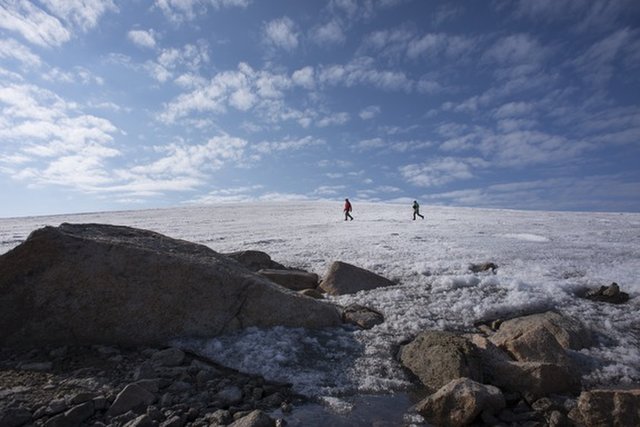
Rapidly receding glaciers within the Canadian Arctic have created an opportunity for scientists to gather samples of the ancient delicate vegetation that has been preserved under the ice. Once exposed they soon start to get destroyed by the wind and water, so before that happened there exists a narrow window in which samples can be obtained. By carbon-14 dating the samples they can then determine when the area was last exposed, hence draw conclusions from that.
What does their newly published study tell us? Let’s take a look.
Study: Rapidly receding Arctic Canada glaciers revealing landscapes continuously ice-covered for more than 40,000 years
We know that the Arctic is warming faster than other regions around the globe because of feedbacks that are unique to the polar regions, but just how unprecedented this is remains a topic of debate.
As the ice recedes, researchers have been able to gather samples entombed plants and date them. This yields the following insight …
Here we show that pre-Holocene radiocarbon dates on plants collected at the margins of 30 ice caps in Arctic Canada suggest those locations were continuously ice covered for > 40 kyr, but are now ice-free. We use in situ 14C inventories in rocks from nine locations to explore the possibility of brief exposure during the warm early Holocene. Modeling the evolution of in situ 14C confirms that Holocene exposure is unlikely at all but one of the sites. Viewed in the context of temperature records from Greenland ice cores, our results suggest that summer warmth of the past century exceeds now any century in ~115,000 years.
Where exactly did they gather samples from?
Baffin Island … here …

The above map shows their sample localities on eastern Baffin Island. White circles indicate locations of plant samples, squares indicate locations with both plant and rock (in situ cosmogenic 14C) samples. Site a is an unglaciated steep-sided summit where only rock was sampled (imagery: Google Earth: Image IBCAO, Landsat/Copernicus)
Further Images
Below is an example of a sample.



Further Insights from their Press Release

The associated institute where the researchers are from, The University of Colorado, Bolder, has also published a press release here. I’ve extracted the following author quotes from there …
…“The Arctic is currently warming two to three times faster than the rest of the globe, so naturally, glaciers and ice caps are going to react faster,” said Simon Pendleton, lead author and a doctoral researcher in CU Boulder’s Institute of Arctic and Alpine Research (INSTAAR). …
…“We travel to the retreating ice margins, sample newly exposed plants preserved on these ancient landscapes and carbon date the plants to get a sense of when the ice last advanced over that location,” Pendleton said. “Because dead plants are efficiently removed from the landscape, the radiocarbon age of rooted plants define the last time summers were as warm, on average, as those of the past century.”…
…“Unlike biology, which has spent the past three billion years developing schemes to avoid being impacted by climate change, glaciers have no strategy for survival,” said Gifford Miller, senior author of the research and a professor of geological sciences at CU Boulder. “They’re well behaved, responding directly to summer temperature. If summers warm, they immediately recede; if summers cool, they advance. This makes them one of the most reliable proxies for changes in summer temperature.”…
… When compared against temperature data reconstructed from Baffin and Greenland ice cores, the findings suggest that modern temperatures represent the warmest century for the region in 115,000 years and that Baffin could be completely ice-free within the next few centuries.
“You’d normally expect to see different plant ages in different topographical conditions,” Pendleton said. “A high elevation location might hold onto its ice longer, for example. But the magnitude of warming is so high that everything is melting everywhere now.”
“We haven’t seen anything as pronounced as this before,” Pendleton said.
Further Reading
- National Geographic: These Arctic glaciers are smaller than ever before in human history
